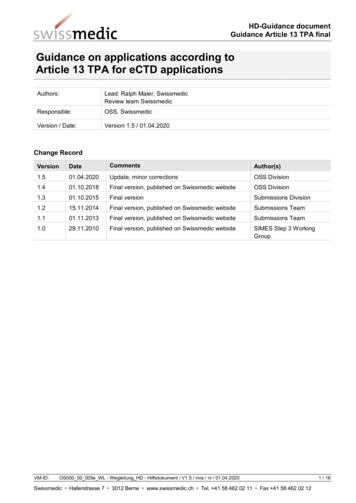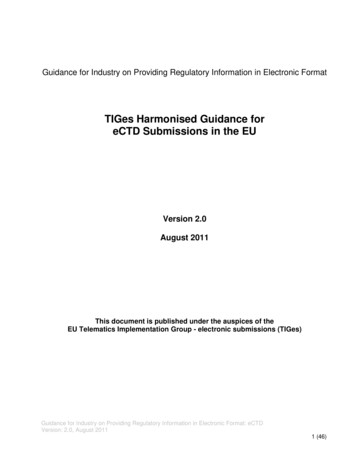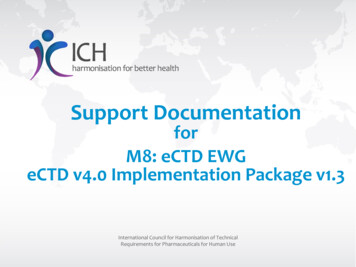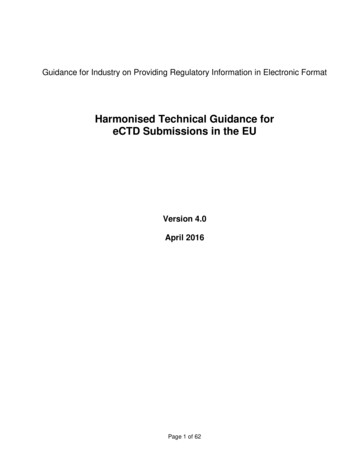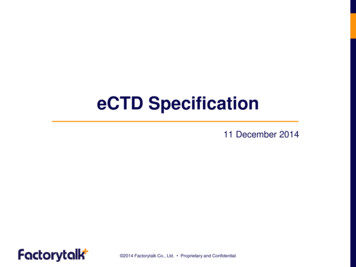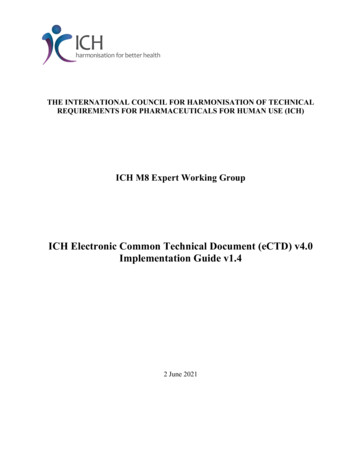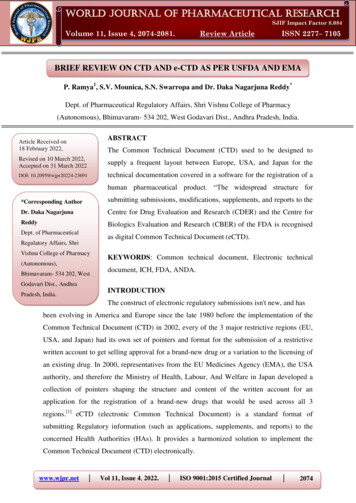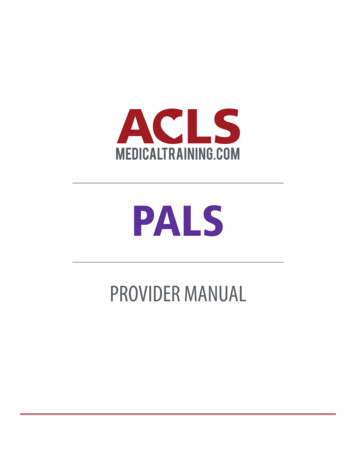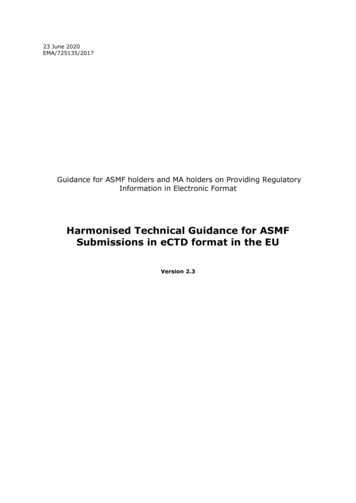
Transcription
23 June 2020EMA/725135/2017Guidance for ASMF holders and MA holders on Providing RegulatoryInformation in Electronic FormatHarmonised Technical Guidance for ASMFSubmissions in eCTD format in the EUVersion 2.3
TABLE OF CONTENTS1. Introduction/Background . 32. General Principles . 32.1 ASMF submission types: . 32.1.1National Submissions – For National, MRP, DCP applications . 32.1.2EU ASMF submissions - For NAPs (NP, MRP, DCP), CAPs or mixed . 32.1.3 EMA ASMF submissions – For CAPs only . 42.1.4 Submission channels . 53. Structure of the eCTD Dossier for the ASMF . 53.1 Differentiation between Applicant’s Part/Restricted Part . 53.2 Example eCTD Structure for the ASMF . 83.3 Example Envelope Elements and Metadata for ASMF Dossiers . 103.3.1 Sample ASMF eCTD envelope in Centralised Procedure . 113.3.2 Sample ASMF eCTD envelope in National Procedures . 124. Lifecycle and Sequencing . 154.1 eCTD Baseline Submission . 154.1.1 Centralised Procedure . 154.1.2 National Procedures . 164.2 Lifecycle Management of the ASMF . 164.2.1 Centralised Procedure . 164.2.2 ASMFs used in Multiple Procedures . 165. How should the ASMF Holder provide information to the MAH? . 176. Including the Applicant’s Part of the ASMF in a MA Dossier . 177. Glossary . 18Document Change . 19Document Revision History . 20 EMA 20202
1. Introduction/BackgroundThe purpose of the document is to provide guidance on the use of eCTD for the submission of ActiveSubstance Master Files (ASMF), and should be read in conjunction with the already-availableguidance on the eCTD and ASMF procedure handling as well as with other applicable guidelines forall European marketing authorisation procedures (CP, MRP, DCP, NP).This guidance should be used in case submission in electronic format for ASMF is accepted orrequired in eCTD format. For a mandatory date of usage please refer to the esubmission website ornational Competent Authorities’ websites.For further practical information on the general requirements for eCTD and general guidance as tohow to build an eCTD, Active Substance Master Files holders and Applicants should also refer to: Harmonised Technical Guidance for eCTD submissionsHarmonised Technical Guidance for Non-eCTD electronic SubmissionsThe ICH eCTD specification V3.2.2The EU M1 eCTD SpecificationEMA presubmission Guidance, question 21Active Substance Master File Holders and Applicants should treat this guidance as complementaryto the current regulatory guidance relating to ASMF (available on EMA website).In the above referenced documents the terms ‘applicant’ and ‘application’ are commonly beenused. In the context of this guidance document, the applicant for an ASMF is the ASMF holder andthe application is equivalent to the ASMF being managed by the ASMF holder.For information on eCTD format requirements in CEP submissions please refer to EDQM.2. General PrinciplesAlthough the prescribed eCTD structure can accommodate the submission of data required for theASMF, it should be clarified that the eCTD ASMF dossier remains, from a technical perspective, astandalone dossier and is distinct from the marketing authorisation dossier and lifecycle. The eCTDASMF dossier will be submitted with its applicant part and restricted part by the ASMF holder andwill have its own lifecycle.The marketing authorisation application and the ASMF may not have the same format. However, ifthe MAA is in eCTD format then the applicant part of the ASMF should be included also in eCTDformat.2.1 ASMF submission types:2.1.1National Submissions – For National, MRP, DCP applicationsThe ASMF holders are encouraged to submit the ASMF dossier in eCTD format if not otherwisecommunicated by the NCA. . It depends from procedure and NCA policy whether a dossier numberneeds to be requested in advance.2.1.2EU ASMF submissions - For NAPs (NP, MRP, DCP), CAPs or mixedThe voluntary EU ASMF worksharing process is applicable to new ASMFs (not formerly assessed aspart of an EU procedure), submitted as part of a new marketing authorisation, or a variationapplication, through the Centralised, Mutual Recognition or Decentralised procedure, where a fullassessment report will be prepared by a Competent Authority. This enables assessors to harmonisereports and avoid duplication. A ‘work sharing ASMF’ is an ASMF that requires an EU/ASMF referencenumber (EU/ASMF/xxxxx). This is obtainable from the Member States (RMS) or from the EMA. Incase of any future submission, this number always has to be referred to in the Letter of Access, theeCTD envelope (optional high level submission number element and mandatory procedure tracking EMA 20203
number element as well) and in the submission cover letter where applicable. The ASMF holder isalso responsible to inform the relevant Marketing Authorisation Holder (MAH) of this number.It is not possible to apply for the EU/ASMF reference number without a future MAH and product asfor the application of the EU/ASMF number it is important to know the future procedure number ofthe marketing authorisation application. The request for the EU/ASMF number should be sent tothe future RMS of the DCP or EMA and therefore the procedure number must be available.Worksharing program and EU worksharing number can be used for for different MarketingAuthorisations Holders. The intention of the ASMF-worksharing procedure is to have one ASMFwith one EU/ASMF-number which will be assessed only once for different clients (marketingauthorisations), which would lead to saving recourses for ASMF-holders, MAHs and competentauthorities.It is not possible to combine EMA & Country specific envelopes while combining thecentralised & national DCP/MRP procedures.For ease of lifecycle management of the ASMF in Europe it is advised that for an ASMF there willbe only one eCTD lifecycle. This implies that the initial submission of the ASMF submitted inrelation to the first marketing authorisation or variation procedure will be sequence 0000. Eachsubsequent procedure will be the next sequence in this lifecycle.For example:When for the first MA procedure sequences 0000, 0001 and 0002 of the ASMF have beensubmitted to some member states (e.g. MS1, MS2 and MS3), and the ASMF has been approved,then the submission in relation to new countries (e.g. MS4, MS5 and MS6) in support of a next MAprocedure will consist of sequences 0000, 0001, 0002 and 0003. The previously submittedsequences 0000, 0001 and 0002 should now also be submitted to MS4, MS5 and MS6. The newsequence 0003 will consist of the cover letter and letters of access for the new MSs and procedure.The sequence tracking table should detail to which countries which sequence has been submittedand when.In case a consolidated 0000 sequence would be submitted in support of the new MA procedure,this would lead to a new eCTD lifecycle for the same ASMF. This would result in the need ofmaintenance of multiple eCTD lifecycles of the same ASMF which is inconvenient for ASMF holderand competent authorities as this could lead to errors where the same updates are notimplemented for all lifecycles and duplicate work.Therefore, it is strongly recommended to have only one lifecycle for the ASMF in the EU.Note: ASMFs for veterinary use only can be submitted in eCTD, CTD (NeeS) or VNeeS format. Theabove applies only to the eCTD format.Please use the eCTD tracking table to maintain/have bettervisibility of the eCTD sequences used in two parallel lifecycles.2.1.3 EMA ASMF submissions – For CAPs onlyASMFs submitted to the EMA for CAPs can have either an EU/ASMF number or an EMEA/ASMFnumber. This is to simplify the processing and assessment and reduce the burden of multiplicationof ASMF submissions of same substances that are contained in multiple centrally authorisedproducts.ASMF holders should not apply for EU/ASMF/xxxxx and EMEA/ASMF/1xxxxx numbers for the sameASMF as it will lead to non-acceptance and negative validation. EU/ASMF/xxxxx andEMEA/ASMF/1xxxxx numbers are not interchangeable.Requirements when submitting an ASMF that has one or more existing pharmaceutical product/eCTDlifecycle(s): The ASMF holder should select which lifecycle they wish to carry on with. The previouslysubmitted versions most often have different eCTD sequence numbers depending on the dateof authorisation of the related CAP. The suggestion is to carry on with the ‘highest’ sequencenumber as it would have the most information on the same substance. The EMEA/ASMF/1xxxxnumber requesting letter should contain this information and list all the CAPs relating to thisASMF. Once the ASMF holder is submitting an update or new version to the ASMF, they haveto do so with the EMEA/ASMF/1xxxx number. The ASMF holder will have to prepare a newsequence (using the next number in the eCTD lifecycle) in which (in the module 1, coverletter) they declare that the previously submitted ASMF version has not been modified sinceit was last submitted. The related CAPs have to be listed. At this time the previously submittedother dossiers will become redundant and the dossier will be renamed as per theEMEA/ASMF/1xxxx number, covering all listed CAPs. EMA 20204
If there have been modifications (new version) since the last ASMF submission, therelevant modules within this new eCTD sequence will also have to be updated.2.1.4 Submission channelsThe submission channels do not deviate from common requirements.All ASMF submissions directed to EMA for Centrally Authorised Products have to be uploaded viaeSubmission Gateway and it will be shared through the Common Repository. Please refer to therespective guidance documents.ASMF submission submitted to NCAs will in most cases be accepted via CESP. Please refer to detailednational information at the CMDh website and the CESP website.3. Structure of the eCTD Dossier for the ASMFThe CTD structure applies to the ASMF. The granularity and placement of documents should followthe existing guidance’s and Q&As from ICH and EU. For an initial ASMF, the relevant modules areM1, M2.3 and M3.2.S, and these modules should be populated as follows: M1 includes the Cover Letter with the Letter of Access, Submission Letter andAdministrative Details, and Withdrawal of Letter of Access (Annex 4 of the ASMFGuideline), where applicable, as one annex, in 1.0, and Information about Expert in 1.4.1.It may include an Application Form in 1.2, depending on national requirements.M2 includes Summary information in 2.3.SM3 includes relevant quality information in 3.2.SNot all modules may apply for subsequent submissions and some additional sections may need tobe used (e.g. for responses to lists of questions). Please consult EMA Presubmission guidance Q&Ano. 21 for more information on the data to be submitted at the different stages of the procedure orlifecycle of the ASMF. The same principles apply for nationally submitted ASMF eCTD sequences.When there is any change to the ASMF data, in line with general eCTD principles, only updateddocuments should be submitted with the respective eCTD operators.3.1 Differentiation between Applicant’s Part/Restricted PartThe overall content of the ASMF should contain detailed scientific information as indicated under thevarious headings of the relevant Notice to Applicants for Marketing Authorisations for MedicinalProducts in the Member States of the European Union (NtA).ASMFs linked to human medicinal products should be presented in the format of the CommonTechnical Document (CTD).ASMFs linked to veterinary medicinal products should normally be presented in accordance with theformat given in Annex 1 table 2, however in accordance with Parts 1.C and 2 of Directive 2001/82/ECas amended, all parts of such ASMFs (AP, RP, and their summaries) may be presented in the CTDformat in the following circumstances (a correlation table should also be provided for ASMFs forVeterinary applications presented in the CTD format): Where the active substance has been included in a medicinal product for human useauthorised in accordance with the requirements of Annex I to Directive 2001/83/EC asamended; In the case of any application for an animal species or for indications representing smallermarket sectors; Where the competent authority has publicly announced this possibility. EMA 20205
The scientific information in the ASMF should be physically divided into two separate parts, namelythe Applicant’s Part (AP) and the Restricted Part (RP). The AP contains the information that the ASMFholder regards as non-confidential to the Applicant/MA holder, whereas the RP contains theinformation that the ASMF holder regards as confidential, see Annex 1. It is emphasized that the APis still a confidential document that cannot be submitted by anyone to third parties without thewritten consent of the ASMF holder. In all cases the AP should contain sufficient information toenable the Applicant/MA holder to take full responsibility for an evaluation of the suitability of thespecification for the active substance to control the quality of this active substance for use in themanufacture of a specified medicinal product.The RP may contain the remaining information, such as detailed information on the individual stepsof the manufacturing method (reaction conditions, temperature, validation and evaluation data ofcritical steps) and the quality control during the manufacture of the active substance. The NationalCompetent Authorities/EMA may not accept that particular information has not been disclosed to theApplicant/MA holder. In such cases, the National Competent Authorities/EMA may ask for anamendment to the AP.In addition to the AP and RP, the ASMF should contain a table of contents, and separate summariesfor both the AP and the RP. In cases where the ASMF is provided in the CTD format, both summariesshould be presented as a Quality Overall Summary (QOS). In cases where the veterinary NtA formatis used, they should be detailed and critical summaries. Each version of the AP and RP should haveunique and independent version control numbers.The ASMF should be submitted as one eCTD sequence, where sections 2.3.S and 3.2.S branch intotwo parts, first the Applicant’s Part and then the Restricted Part. The eCTD meta-data should beused to distinguish the two parts.The prefix ‘AP or ‘RP’ should be added to the substance meta-data value, and in addition theprefix ‘AP’ or ‘RP’ should be added to every leaf title in the respective section.It is recommended that the suffix ‘ap’/‘rp’ is also applied to the file names.In some cases in where the ASMF is used to support applications in a number of different proceduresor where the API is used in different formulations, the requirements for one MAA may requireadditional documentation to be included into the ASMF eCTD dossier1. These documents can beincluded within the ASMF eCTD by adding an extension to the file name to identify the procedure orMAA application (see Figure 3 below) and by including some specific information about this as partof the prefix in the leaf title , after the “ap” or ”rp”.Figure 1: ASMF AP leaf title sample1In these cases the participation in the ASMF AR WS is strongly recommended. EMA 20206
Figure 2: ASMF AP file name sampleDocuments that are the same in both the AP and RP sections should be included only once andplaced in the AP section of the folder structure. The leaf in the RP section will therefore point to thefile in the AP section folder. EMA 20207
3.2 Example eCTD Structure for the ASMFThe example below shows a possible stylesheet view of an eCTD ASMF submission: DTD nodes (e.g. m3-2-body-of-data) appear in black as in the official stylesheet. Notethat all module 1 section titles are displayed by the m1 stylesheet, whether the section ispopulated or not; in other modules, the section title is only displayed if the section ispopulated with file(s). Leaves are references to files in the eCTD, and each leaf has a leaf title which is not thesame as the underlying PDF file name. Leaves appear in blue (because of the hyperlink toa PDF file). It is the suggested eCTD leaf title that is attributed to the file, not theunderlying PDF filename, which is displayed in the example. The leaf titles displayed in theexamples are intended as a guide only – other leaf titles can be used as appropriate. Some leaves illustrated may not be applicable for all ASMF submissions.Submissions should otherwise be built in line with the eCTD guideline for MAAs as regardsstructure/placement, envelope elements and metadata. EMA 20208
EMA 20209
Figure 3: Samples of additional metadata of the leaf3.3 Example Envelope Elements and Metadata for ASMF DossiersThis section describes how the envelope elements should be used in the eCTD when submittingASMF dossiers submitted by the ASMF holder.Generic information on the eCTD envelope and the mandatory/optional elements are provided in theEU eCTD module 1 specification.The information provided in the envelope is very important and it is used to identify, display andgroup the individual eCTD submission dossiers, and is also automatically extracted by the reviewtools (software) for dossier display.Some of the key envelope elements must be populated using a pre-defined pick-list of values. Othersallow the inclusion of free-text.Table 1: Envelope Meta-Data (based on EU M1v3.0.1)ElementAttribute Notes on Usageeu-envelopeEnvelopecountryFor CP EMA, for all other countries the respective value fromthe pick list should be selected.IdentifierThe UUID will be assigned by the ASMF holder. As it is anidentifier for the dossier, the same UUID will be used for allsequences of an eCTD ASMF dossier.submissiontypeAll ASMF applications and updates or responses to questionsshould use the value “asmf” in all cases even this is abaseline (Note: This is an exemption from rule for humanmedicinal products).modeNot to be used with the ASMFnumberNot requiredprocedure-trackingnumberFor submissions related to Centralised (EMEA) andWorksharing procedures (EU), this section should ALWAYScontain the EMEA/ASMF/xxxxx or EU/ASMF/xxxxx numbers.See EMA Presubmission guidance Q&A no. 21 and ASMFWorking Group webpageFor other procedures, if a specific ASMF number has not yetbeen allocated by the NCA the term “To be advised” shouldbe used.submission-unitThe initial ASMF application should use the value “initial”. EMA 202010
Follow-up sequences submitted as part of an ASMFprocedure should always use the value “response” (e.g.responses to deficiency letters, responses to questions andalso for all amendments and/or updates to the ASMF initiatedby the ASMF holder). Due to a normally slow life cycle thisrecommendation simplifies the selection without requiringspecific rules as well as not confusing the receiving agencies.In case of submitting other information (could include, forexample, missing files) “additional-info” should be used andonly, if “response” is not suitable.If a baseline ASMF is being provided for future lifecycleactivities then the value “reformat” should be used.The ASMF Holder name should be usedapplicantagencycodeFor CP EU-EMA, for all other agencies the respective valuefrom the pick list should be selected.typeFor CP use “centralised”For all other instances (MRP, DCP and NP), in case the ASMFis submitted to only one agency, use “national”.In case the ASMF is sent out to more than one agency, use“mutual-recognition”.procedurePlease note that the use of “mutual-recognition” isindependent of the application type of the drug product andwill cover decentralised procedures as well. It only indicatesif the ASMF has been sent to more than one agency. Usingthis procedure type makes sure, that a validation error is notdetected.The ASMF holder is recommended to include their own ASMFspecific internal code and/or internally used namePlease be as precise as possible - for example, include anycodes to identify the specific route of synthesis,manufacturing site, quality (particle size, grade, etc.).If no code or name is available use the value “Not available”.Refer to the EU Module 1 specification.Refer to the EU Module 1 specification.For ASMF submissions this will always be 0000, both for theinitial sequence and for all subsequent submissions. There isonly one reference required.This element is also used to provide a free text description ofthe sequence.This element can be used to provide the date and/or versionnumber of the applicant part and the restricted part of bmission-description3.3.1 Sample ASMF eCTD envelope in Centralised ProcedureThe figures below show an example set of envelope information for a Centralised Procedure ASMFboth in the source XML and also when viewed using the EU stylesheet in a standard internet browserapplication. Note: the XML shows that the related sequence has not been used, although thestandard stylesheet automatically creates an entry for this information, even when the field remainsempty. EMA 202011
Figure 4: Samples of the XML part and display of the envelope for centralised procedures3.3.2 Sample ASMF eCTD envelope in National ProceduresThe figures below show an example for an ASMF used on a national basis in three countries (Austria,France and Sweden). The figures illustrate the view of the envelope elements in the XML backbone(eu-regional.xml) and the same information when viewed using the standard EU Module 1stylesheet. EMA 202012
EMA 202013
Figure 5: Samples of the XML part and display of the envelope for other procedures EMA 202014
4. Lifecycle and SequencingThe ASMF is a standalone dossier, separate from the marketing authorisation applications that areaffected by it. The lifecycle of the ASMF should therefore be managed independently. When avariation application impacts the details related to the ASMF both Module 3 of the MA and the ASMFhave to be updated to reflect the changes being requested. Whilst the MAH has to apply for avariation the ASMF Holder should submit the updated ASMF as “additional-info”.Leaf lifecycle management should be conducted in the same way as for MAAs, using the appropriateoperation attribute values.An already-submitted ASMF might be referred to by another MAA. In this case, the ASMF Holdershould only update Module 1 in the eCTD sequence and submit it to the relevant Authorities, alwaysquoting the assigned ASMF numbers (EU or EMEA or National). The new MAA holder also has toensure that they refer to this number.The Letter of Access should only be submitted once for a given MA applicant or holder. The Letter ofAccess may state more than one procedure number or more than one letter can be included if theASMF is in use for different products. The ASMF holder should not submit the Letter of Access forthe product dossier in addition. If at a later point in time additional Letters of Access need to besubmitted, the next sequence number must be used for this content to maintain the ASMF dossierlife cycle correctly. In all cases it is valuable to include the procedure number of the marketingauthorisation application the ASMF will be used for.4.1 eCTD Baseline SubmissionThe baseline eCTD submission should be sequence 0000 2, regardless of the current submissiontracking, as this marks the beginning of the tracking of the lifecycle in the eCTD. The Cover Lettershould clearly indicate that the baseline submission does not form part of a procedure as such andis not for review, but is merely provided as an eCTD ‘baseline’ and an aid to lifecycle management.The envelope element submission type chosen for this reformatted submission should be ‘asmf’and the submission unit type needs to be ‘reformat’. The submission description envelopeelement should be used to clearly indicate the baseline nature of the submission.In the case of submission of a baseline sequence, a signed declaration from the ASMF Holder mustbe provided as an annex to the Cover Letter, stating that the content/data of the submitted modulesin eCTD format is identical to the currently approved ASMF, and that there have been no changesto the dossier content as a result of the provision of an eCTD submission.4.1.1 Centralised ProcedureWhen converting from NeeS to eCTD, the EMA requires a sequence 0000 baseline conversion at thetime of the update of the ASMF dossier. This should be submitted with the correct EMEA/ASMF/xxxxxnumber or EU/ASMF/xxxxx number. The ASMF holder has to apply for a procedure number inadvance in any case.The reformatted ASMF eCTD baseline submission will not be assessed if it is a stand-alonesubmission. It will merely be loaded into eCTD review tools to serve as a baseline as the namesuggests, to facilitate future eCTD lifecycle management of the ASMF. A declaration in the coverletter should state that no changes have been introduced to the content of the previously accepteddossier.If an ASMF holder has more than one eCTD lifecycle filed for the same substance, they will need toobtain an EMEA/ASMF/xxxxx number. They will also need to decide which existing lifecycle they wishto carry on with. After this the ASMF has to be submitted only once (and will relate to all the multipleCAPs that are listed in the M1 Cover letter.In exceptional circumstances the sequence number may not be 0000, the ASMF holder will need to liaise with theNCAs in such cases.2 EMA 202015
4.1.2 National ProceduresAlthough there is no obligation to do so, it is highly recommended that ASMF Holders converting theASMF dossier to the eCTD format first submit a ‘baseline’ eCTD dossier to all MS as well as to theMAH, when applicable.The eCTD baseline submission would in these cases be the first officially submitted dossier in eCTDformat for applications previously managed in paper or other electronic formats. The intent of thebaseline submission is that it should contain the current ASMF certified data on which future lifecyclemanagement changes can be made.4.2 Lifecycle Management of the ASMF4.2.1 Centralised ProcedureAn ASMF used in a Centralised Procedure only should be produced following the general eCTDpractical guidance published by the EMA.The lifecycle should be managed as a single submission to the EMA, no other countries should beincluded in the envelope or country specific information. The tracking of sequences and themanagement of the relationships between submitted documents should follow the standard eCTDrules described in the ICH eCTD specification.Where the ASMF is used for several products, the cover letter submitted to the EMA should list all ofthese products. A separate eCTD lifecycle is required for ASMFs used in the centralised procedure.4.2.2 ASMFs used in Multiple ProceduresWhen ASMFs are submitted to multiple NCAs (but not EMA), ASMF holders may benefit frommanaging a consolidated lifecycle for the ASMF eCTD and sharing this lifecycle with the individualagencies. However, individual eCTDs for each agency may also be appropriate depending on thecomplexity of the life cycle. The ASMF holder should chose the most appropriate approach.Reference is made to the CMD(h) Best Practice Guide for eCTD in MRP/DCP(http://www.hma.eu/277.html) for the principles of lifecycle management and to the diagramsillustrating the way in which the sequences are managed. The practices described in the CMDh BPGfor MAA dossiers can also be applied to the management of the ASMF lifecycle across the agencieswhere the ASMF has been submitted.When submitting the ASMF to countries that have not previously received the ASMF, the ASMF holdershould follow the principles of the guidance about the Repeat Use Procedure in the CMDh BPG. Onceconfirmed with the agency the ASMF holder should submit identical copies of all previously submittedASMF eCTD sequences to the new agency. They can then use the eCTD tools at their disposal tobuild a “current view” of the ASMF from the sequences previously submitted to other countries. Thiswill serve as the basis for the initial approval in the new country and the future lifecycle managementof the ASMF.According to the eCTD specification, the Module 1 eCTD XML file (eu-regional.xml) contains anenvelope element for every country/NCA that is going to receive that particular sequence. If aparticular eCTD sequence has no content relevant for a particular country, the eCTD should notcontain an envelope element for that country. However, the submission should still be sent to theother RMS/C
Note: ASMFs for veterinary use only can be submitted in eCTD, CTD (NeeS) or VNeeS format. The above applies only to the eCTD format.Please use the eCTD tracking table to maintain/have better visibility of the eCTD sequences used in two parallel lifecycles. 2.1.3 EMA ASMF submissions - For CAPs only
